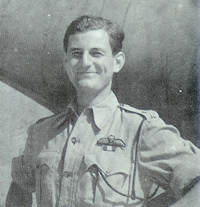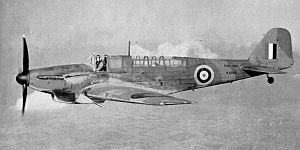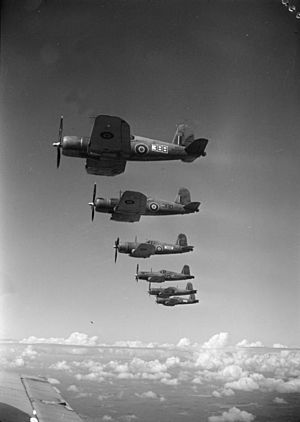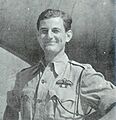Ronald Cuthbert Hay facts for kids
Quick facts for kids
Ronald Cuthbert Hay
|
|
|---|---|

Ronald Cuthbert Hay
|
|
| Nickname(s) | Ronnie |
| Born | 4 October 1916 Perth, Scotland |
| Died | 22 November 2001 (aged 85) Wiltshire, England |
| Allegiance | United Kingdom |
| Service/ |
Royal Marines (1935–51) Royal Navy (1951–66) |
| Years of service | 1935–1966 |
| Rank | Commander |
| Unit | Fleet Air Arm |
| Commands held | 809 Naval Air Squadron 47th Naval Fighter Wing |
| Battles/wars | Second World War |
| Awards | Distinguished Service Order Distinguished Service Cross & Bar |
Ronald Cuthbert Hay, also known as Ronnie, was a brave British naval pilot. He was the only Royal Marine to become a fighter ace, meaning he shot down five or more enemy aircraft. He was awarded the Distinguished Service Order (DSO) and the Distinguished Service Cross (DSC) for his courage.
Born in Scotland in 1916, Hay joined the Royal Marines in 1935. He later became a pilot with the Fleet Air Arm, the air branch of the Royal Navy. During World War II, he flew different types of fighter planes. He took part in important events like the Norwegian campaign, the Dunkirk evacuation, and the Battle of Britain.
In 1944, Hay led a group of fighter planes in the Far East. He flew Vought F4U Corsair aircraft from the aircraft carrier HMS Victorious. He led many major British air attacks against the Japanese. By the end of the war, he had helped destroy many enemy planes. After the war, he joined the Royal Navy and became a commander before he retired in 1966.
Contents
Early Life and Joining the Military
Ronald Cuthbert Hay was born on October 4, 1916, in Perth, Scotland. He was one of five children. He went to school at Ampleforth College in Yorkshire, England.
Because he was a bit too old to join the Royal Navy as a cadet, Hay decided to volunteer for the Royal Marines in 1935. He spent a year at sea on a ship called HMS Devonshire. In 1938, he chose to become a pilot for the Fleet Air Arm.
World War II Adventures
Hay joined 801 Naval Air Squadron, which was based on the aircraft carrier HMS Ark Royal. His squadron flew two-seater planes called Blackburn Skua and Blackburn Roc fighters.
First Victory in Norway
Hay got his first victory on April 27, 1940, during operations over Norway. He described how he shot down a German Heinkel He 111 bomber:
We ran into a Heinkel He 111 bomber... I therefore sat on the tail of the bomber and fired short bursts until it crashed into the sea.
Helping at Dunkirk
On May 31, 1940, Hay's squadron helped cover the evacuation of British soldiers from the beaches at Dunkirk. They used their Skua planes as dive bombers. These planes were not as fast as the German Messerschmitt Bf 109 fighters. After one mission, only four planes from Hay's squadron returned to base.
Fighting in the Battle of Britain
Hay then moved to 808 Naval Air Squadron, which flew Fairey Fulmar planes. This squadron was one of only two Fleet Air Arm fighter squadrons that fought in the famous Battle of Britain. They helped defend Britain against German air attacks.
In October 1940, Hay's squadron rejoined the Ark Royal and sailed to the Mediterranean Sea. Hay continued to fly missions and shot down several Italian planes. In May 1941, they protected a group of supply ships called the Tiger convoy. During an attack by the Italian Air Force, Hay shot down a Savoia-Marchetti SM.79 bomber. This was his sixth confirmed victory.
After the Ark Royal was sunk in November 1941, Hay became a flying instructor. He also received the Distinguished Service Cross (DSC) for his brave actions in the Mediterranean.
Leading Squadrons
In May 1942, Hay was promoted and given command of 809 Naval Air Squadron. This squadron was on the aircraft carrier HMS Victorious. Hay led the squadron during the Torch landings in North Africa. He was promoted again around this time.
Hay later moved to Ceylon (now Sri Lanka) in April 1943. While there, he met and married Barbara Grange, who was also serving in the military.
Battles in the Far East
In August 1944, Hay took command of the 47th Naval Fighter Wing. This group had two squadrons of powerful Vought F4U Corsair planes on HMS Victorious. Their first mission was against the Nicobar Islands in October 1944.
In December 1944, Hay was promoted again. He led a major air raid called Operation Meridian on January 4, 1945. This attack targeted oil refineries and airfields in Sumatra, Indonesia. It was one of the largest operations ever by the Fleet Air Arm. For his leadership, Hay was awarded the Distinguished Service Order. During this mission, Hay's fighters shot down eight Japanese planes, and Hay himself shot down two of them.
At the end of January, Hay's wing attacked the Sumatran oilfields again. Hay helped shoot down more Japanese planes. His wing then supported the American invasion of Okinawa by attacking the Sakishima Islands. Hay received a Bar to his DSC for his leadership in these attacks.
At the end of World War II, Hay was still on board Victorious. He took part in air strikes against the Japanese mainland until August 11, 1945.
Life After the War
After the war, Hay continued flying but was injured in a landing accident. He returned to the Royal Marines and served in places like Malta, Cyprus, Hong Kong, and Malaya.
In 1951, Hay transferred to the Royal Navy. He served on the aircraft carrier HMS Indomitable and held several other positions. He retired from the Navy in 1966.
After retiring, Hay spent about twelve years working in the Mediterranean, chartering boats. He also renovated an old mill near Stonehenge. He appeared in several TV shows about World War II.
Ronald Cuthbert Hay passed away in Wiltshire, England, on November 22, 2001, at the age of 85. He was survived by his four children.
Legacy
In May 2010, the Falkland Islands issued a set of stamps to remember the Battle of Britain. One of the stamps showed Lieutenant Hay's Fairey Fulmar plane, representing the British aircraft that fought in the battle.
Images for kids




